19 Green Birds You Can Spot in Florida
Florida, often called the Sunshine State, is a real treat for nature lovers with its mix of unique plants and animals. It’s especially a paradise for bird lovers. Many of these birds wear bright, eye-catching shades of green that pop against Florida’s natural backdrop.
So, if you’re wandering around Florida hoping to spot some beautiful green birds, we’ve got a handy list ready for you.
Green Birds in Florida
1. Green Heron
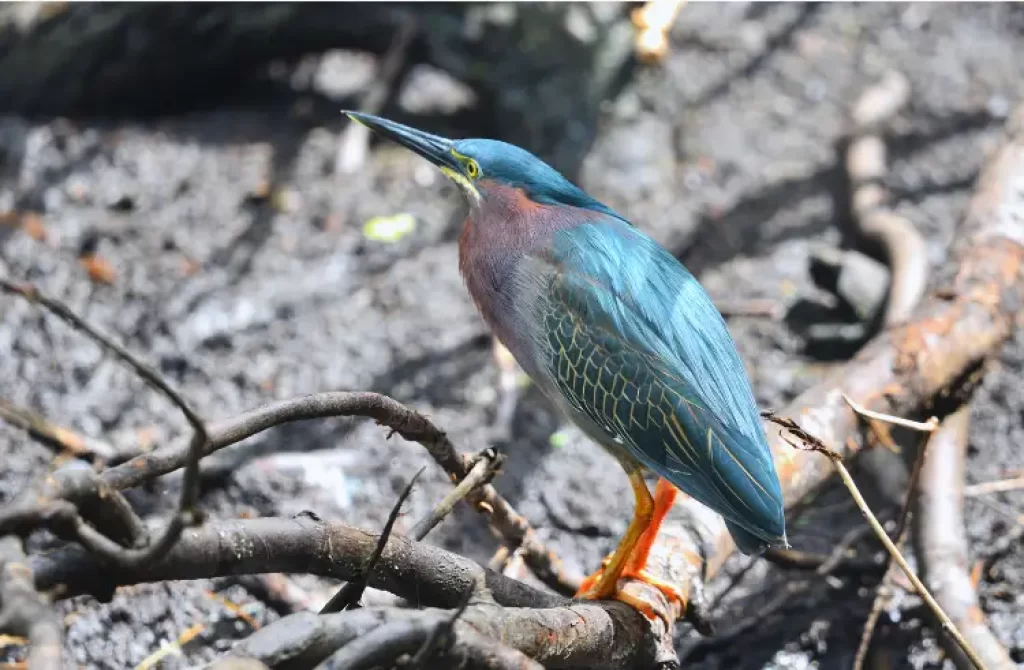
The Green Heron, a vibrant green bird found in Florida, is a sight to behold. With a body length of about 16-18 inches, it’s on the smaller side compared to other herons.
Its deep greenish-blue back and rich chestnut neck make it easily recognizable. This heron has a unique feature: a dagger-like bill, perfect for catching fish and small insects.
While they are commonly seen around freshwater habitats in Florida, their adaptability means you can spot them in various wetlands across the state.
If you ever find yourself exploring Florida’s lakes, ponds, or rivers, keep an eye out for this distinct green bird—it’s one of Florida’s natural treasures.
2. Monk Parakeet (Quaker Parrot)
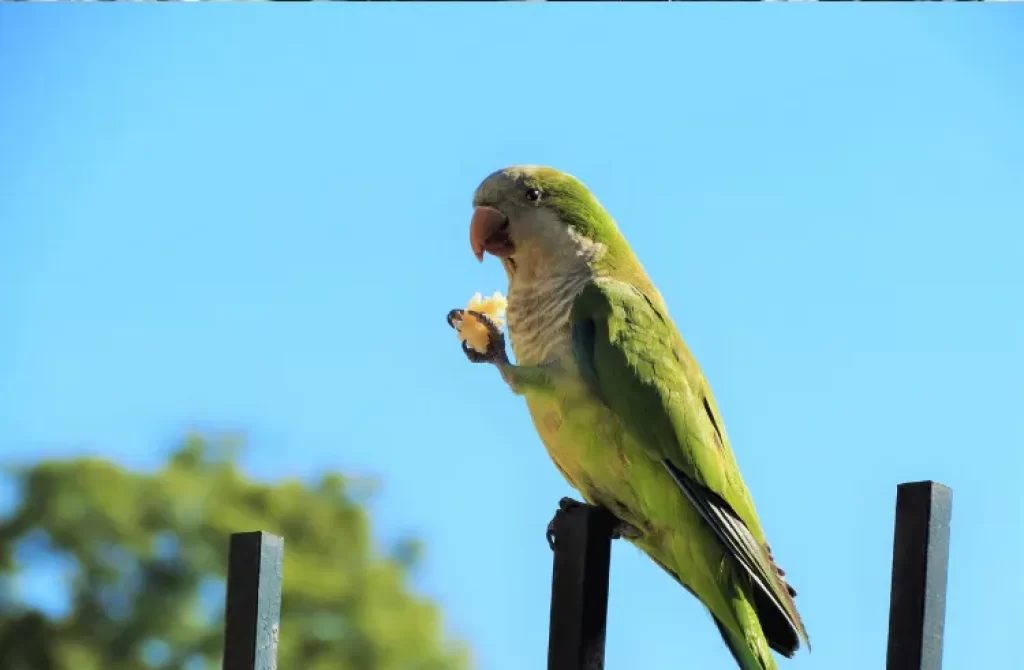
The Monk Parakeet, also known as the Quaker Parrot, is a splash of tropical color in the Florida skies. This green bird, native to South America, has found a new home in the Sunshine State.
Measuring around 11-12 inches in length, it’s distinguished by its bright green plumage contrasted with a characteristic gray face and throat. Although these birds are originally from a different continent, they’ve successfully established colonies in various parts of Florida.
Their loud, chirpy calls and social nature make them hard to miss. Whether you’re a local or a visitor, spotting a Monk Parakeet is always a delightful sight against Florida’s blue skies and palm trees.
3. Painted Bunting
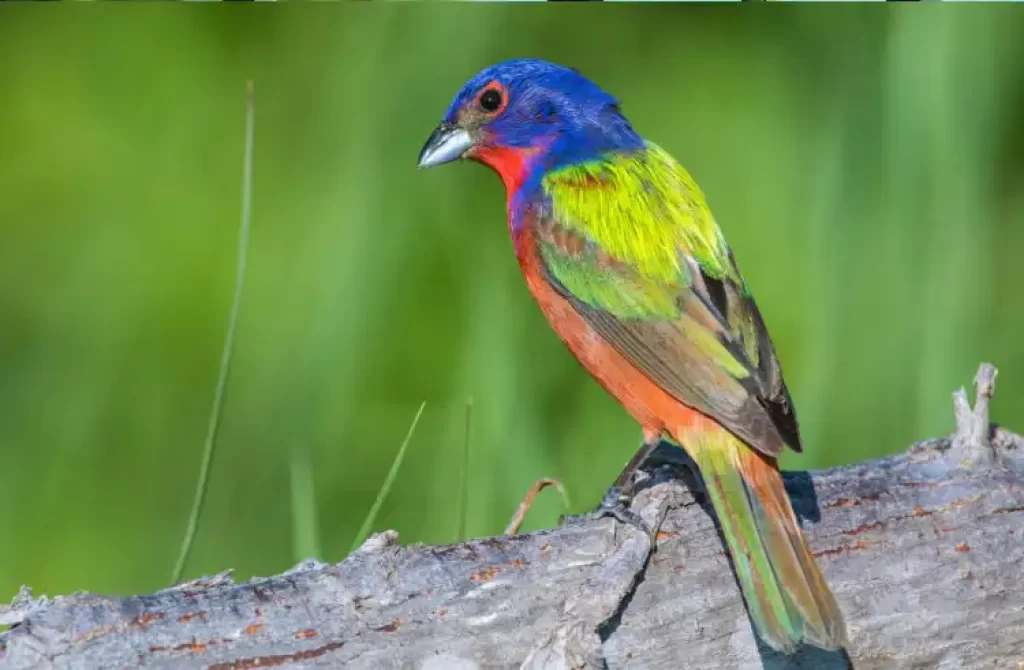
The Painted Bunting is a jaw-dropping sight for anyone lucky enough to spot one in Florida. Male birds of this species wear an incredible array of colors: vibrant blue heads, red underparts, and, fitting our “green bird Florida” theme, a striking bright green back.
These small birds, measuring around 5 inches in length, are like flying rainbows. Their preferred hangouts include brushy areas, thickets, and gardens where they can find seeds, their primary food.
While their vibrant colors might suggest otherwise, Painted Buntings can be somewhat shy, often hiding in dense vegetation.
But with a little patience, Floridians and visitors might catch a glimpse of this dazzling green-backed bird, especially during its song-filled breeding season.
4. White-eyed Vireo
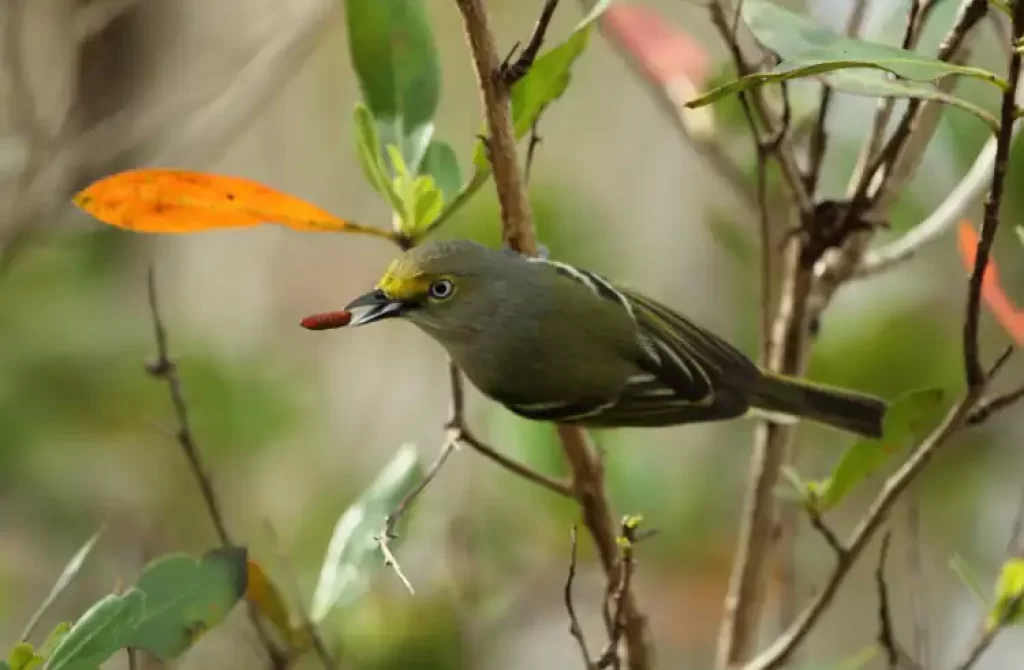
If you’re walking through Florida’s thickets or scrubby woods, keep an eye out for the White-eyed Vireo. This small bird is easy to spot with its bright green back and those unique white eyes that stand out against its face.
It’s a songbird, so if you’re lucky, you might even hear it sing. It’s not just the look that makes it special, but also where it hangs out. They love areas with lots of bushes and trees, places that are a bit wild and overgrown.
So, the next time you’re in such a spot, be on the lookout for this cool green bird with white eyes. It’s one of the neat birds you can find in Florida.
5. Purple Gallinule
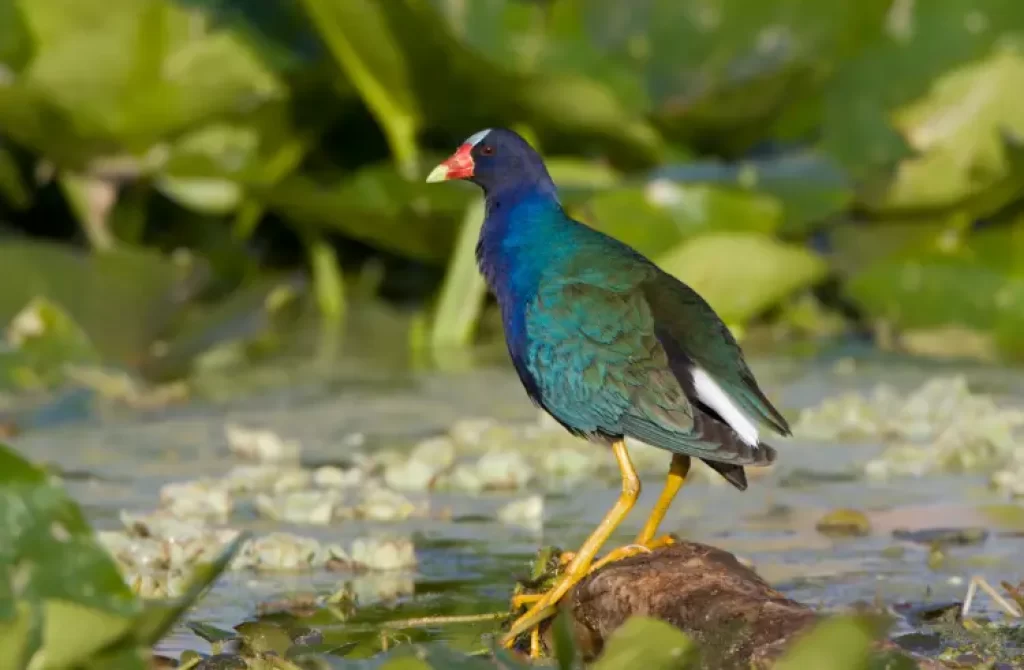
When you think of green birds in Florida, the Purple Gallinule should come to mind. These birds, with their radiant teal-green backs and vibrant purple-blue necks, are truly a visual treat.
Averaging about 12 to 15 inches in length, they possess long, yellow legs and a standout red frontal shield on their forehead, making them easily recognizable.
As adept waders, Purple Gallinules are often seen traipsing through Florida’s freshwater marshes, looking for aquatic plants, insects, and even small fish to eat.
Their large, splayed feet help them walk atop lily pads and floating vegetation, almost as if they’re gracefully walking on water. This colorful bird, with its mix of green and purple, is yet another testament to the rich avian diversity that Florida has to offer.
6. Green-winged Teal
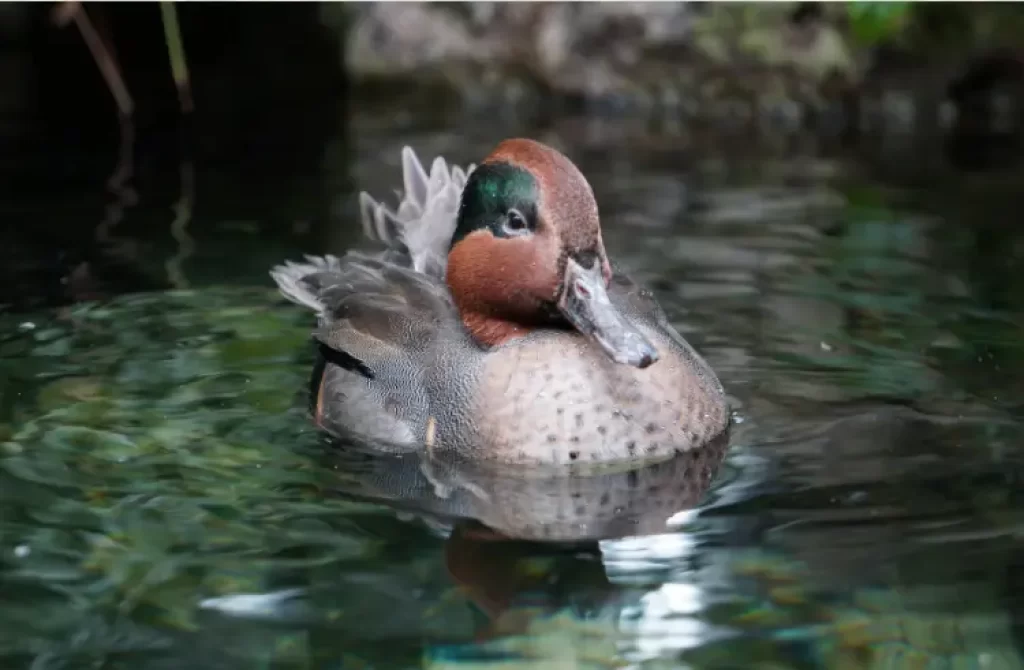
When discussing green birds in Florida, the Green-winged Teal deserves a mention. This small duck, measuring about 11 to 16 inches in length, is easily identifiable by its vibrant green patch that adorns the area around its eyes, contrasting beautifully with its warm brown body.
The male is particularly striking, sporting additional splashes of color like its chestnut head and intricate white vertical stripe on its side.
Preferring the calm waters of ponds, wetlands, and marshes, the Green-winged Teal is commonly seen dabbling for aquatic insects, small fish, and vegetation.
Their swift and agile flight patterns are also a treat to observe. As winter visitors, they grace Florida with their presence, adding to the tapestry of the state’s diverse birdlife. If you’re on a birdwatching trip in Florida, these teals are a must-see.
7. Red-masked Parakeet
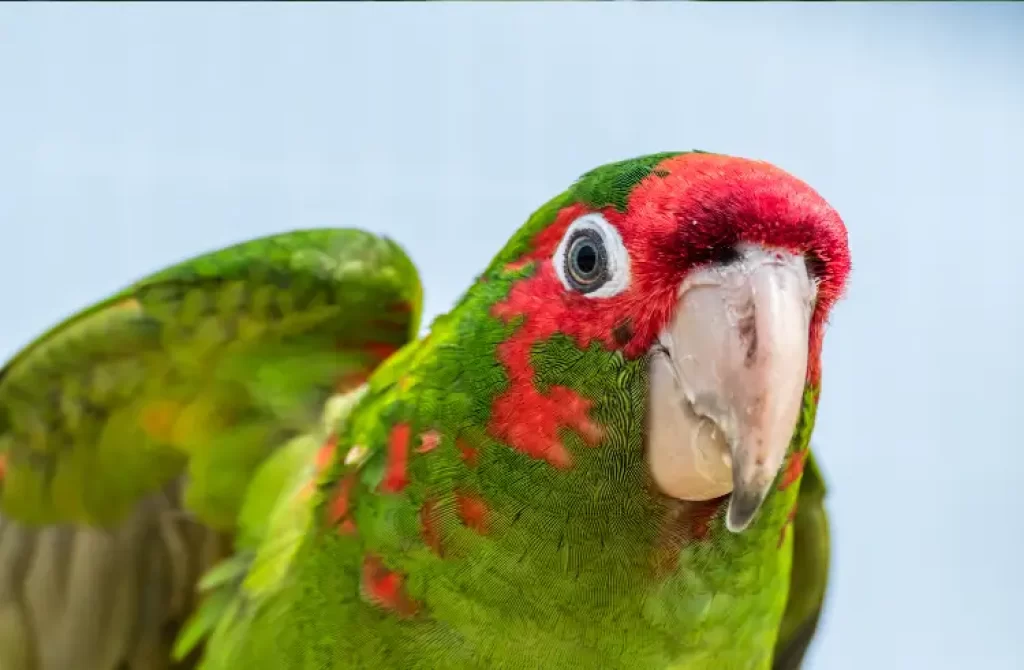
Among the myriad of colorful avians in Florida, the Red-masked Parakeet stands out. Cloaked mostly in vibrant green, this parrot is unmistakably recognized by its fiery red mask, which covers its forehead and eyes, providing a striking contrast. Usually reaching a length of about 13 inches, these birds add a touch of tropical flair wherever they’re spotted.
Although they hail from the tropical regions of South America, a number of these parakeets have made Florida their home. While they aren’t originally from the area, sightings in the wild have become more common, mainly due to pets that have either escaped or were released.
Their chatter and playful antics make them an exciting find for those keen on spotting unique green birds in Florida.
8. Nanday Parakeet
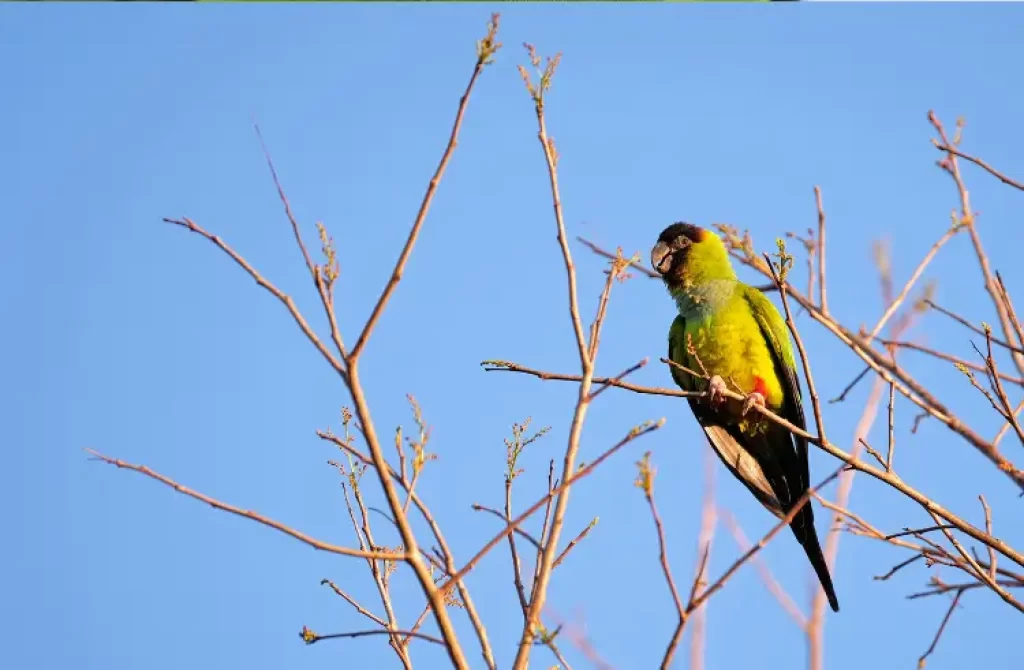
If you’re in Florida and spot a mostly green bird with a standout black head and vivid red legs, you’re likely looking at the Nanday Parakeet.
This bird, roughly around 12 inches long, originally hails from South America. But how did it end up in Florida? Well, sometimes, pets either escape or are released, and these parakeets are one such case.
They’ve now formed their own wild groups, making parts of Florida their new stomping grounds. These birds are easy to spot because of their unique colors.
Their loud calls might give them away too! Even though they aren’t native, they’ve added a lively touch to Florida’s bird scene.
9. Swallow-tailed Kite
When you’re in Florida and spot a bird soaring high with a distinctive silhouette, it might be the Swallow-tailed Kite.
This elegant raptor, measuring about 24 inches in length with a wingspan of over 4 feet, is known for its deep black upper body and contrasting white belly. But if you catch them at the right angle, especially on a sunny day, their wings exhibit a subtle green sheen.
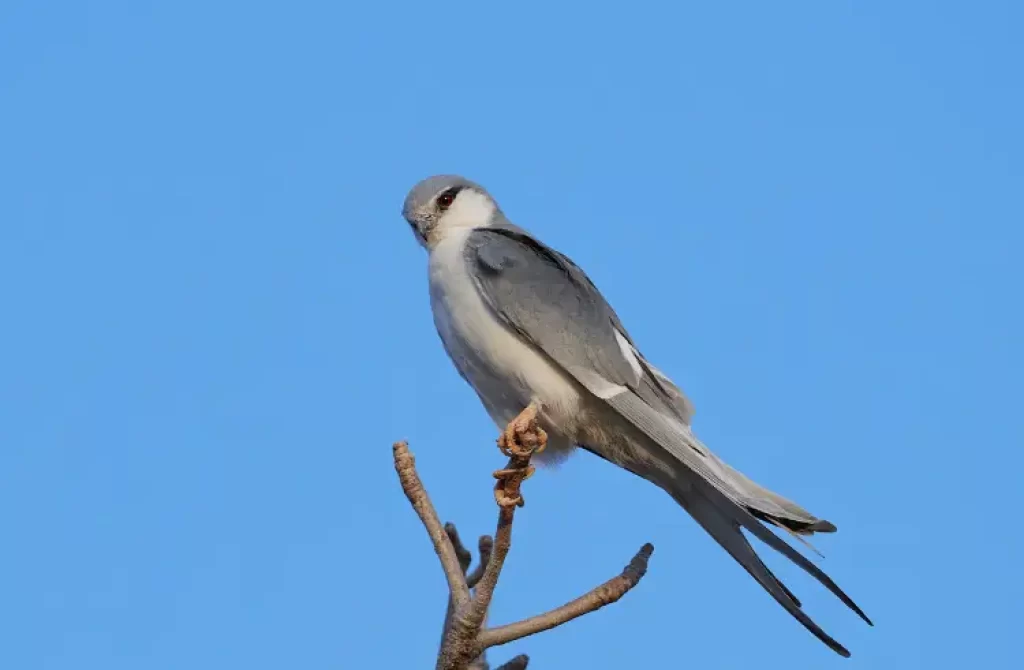
This green hint on their wings makes them stand out and adds to their charm. Mostly seen gliding effortlessly over open areas, their forked tails and agile flight patterns are a spectacle.
These birds are not just beautiful to look at; they play a crucial role in the ecosystem, helping control pest populations. So, the next time you’re outdoors in Florida, gaze up and enjoy the beauty of this “green-winged” marvel.
10. Magnolia Warbler
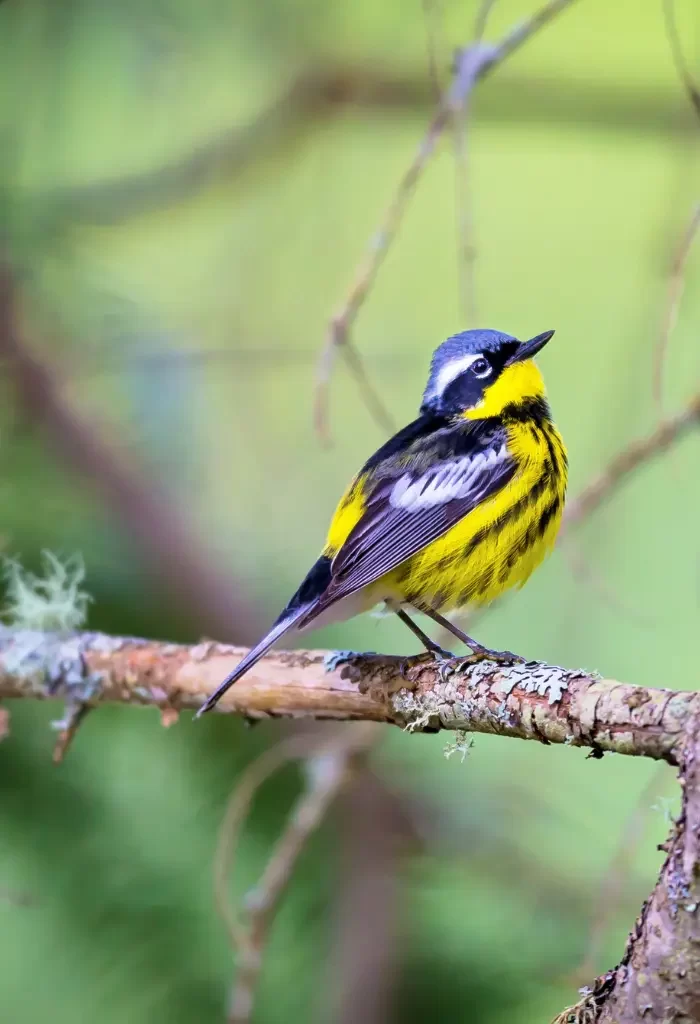
The Magnolia Warbler, often found in Florida during the spring, is a remarkable sight with its vivid yellow belly and contrasting olive-green back.
This bird, which typically measures about 4.5 to 5 inches in length, is distinguished by its distinctive markings: a series of black stripes across its chest and a conspicuous white eye-ring.
As insectivores, Magnolia Warblers actively flit about tree branches, hunting for their primary diet of insects and larvae. During migration seasons, they travel great distances, but in spring, Florida’s forests offer a temporary home.
Their melodious songs, often described as a series of whistled notes, can be heard echoing through the woods, making them a delight for birdwatchers and nature enthusiasts alike.
This green bird, with its dynamic colors and behaviors, exemplifies the avian diversity Florida boasts.
11. Budgerigar (Parakeet)
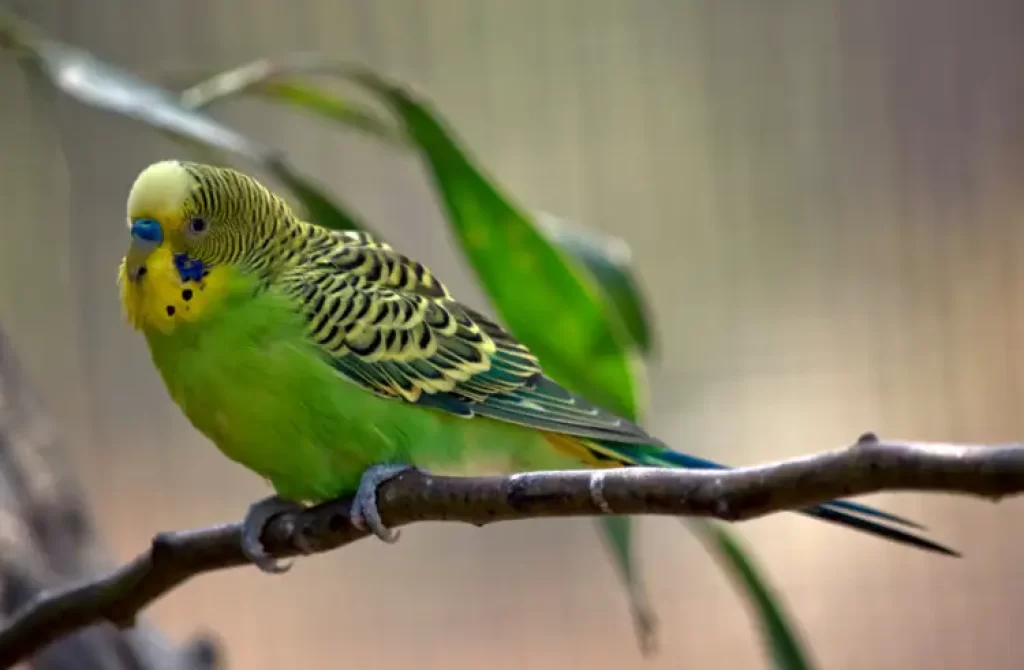
Originating from Australia, the Budgerigar, often referred to as the Parakeet in the U.S., is a bright sight with its predominantly green body and contrasting yellow head. This petite bird averages about 7 to 8 inches in length.
Budgies, as they are commonly called, have a pattern of black stripes down their back and black-spotted yellow wings, giving them a unique look.
While they’re known for their cheerful chirps and ability to mimic sounds, it’s their sociable nature that makes them beloved pets. In Florida, beyond the confines of cages, some Budgerigars have been spotted in the wild, possibly due to escape or intentional release.
Their adaptability and quick breeding rate allow them to survive and even thrive in some of Florida’s environments. So, when you think of a green bird in Florida, the vibrant Budgerigar surely comes to mind.
12. Palm Warbler
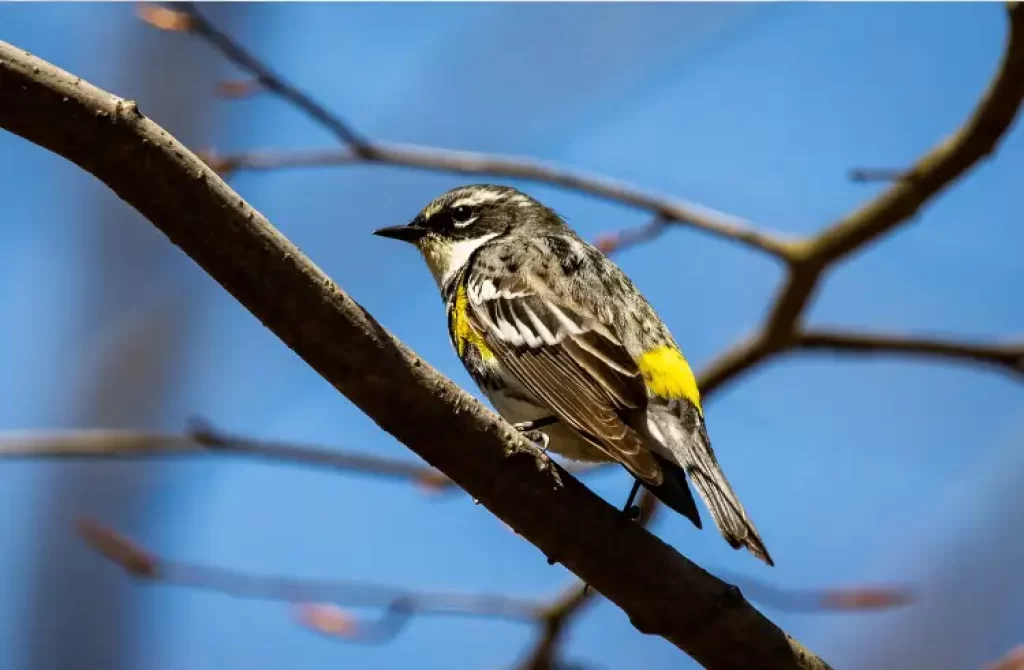
The Palm Warbler is a delightful sight with its streaked brown back, complemented by a bright yellow undertail and subtle olive overtones on its body.
Measuring around 5 to 5.5 inches in length, this small bird can be identified not only by its colors but also by its unique behavior of constantly bobbing its tail. Native to North America, the Palm Warbler is often seen flitting about in open areas, searching for insects which make up a majority of its diet.
While they breed in the boreal forests of Canada, they migrate south for the winter, with Florida being a favored spot.
The state’s warm climate and abundant food sources offer the perfect wintering grounds for these lively birds. If you’re in Florida, especially during the cooler months, keep an eye out for the Palm Warbler, easily recognized by its distinctive tail-wagging habit.
13. Rose-Ringed Parakeet
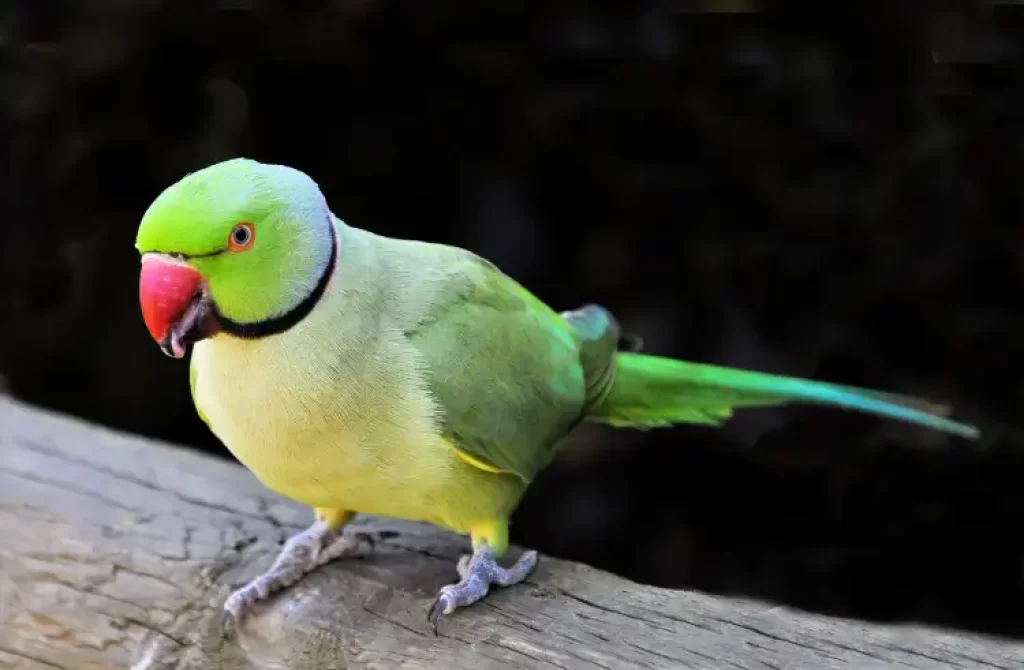
The Rose-Ringed Parakeet, sometimes called the Ring-Necked Parakeet, is a standout with its bright green body. What’s even cooler is that the adult males have a black and rose ring around their necks – hence the name!
These birds originally come from parts of Africa and Asia, but guess what? Some have found their way to Florida and made it their home, likely from escaped pets.
They’ve got a pretty loud call, so if you hear something that catches your attention, look up! You might just spot one of these vibrant green birds perched in the trees or flying around.
While they might not be native to Florida, they sure add a splash of color to the local bird scene!
14. Mourning Warbler
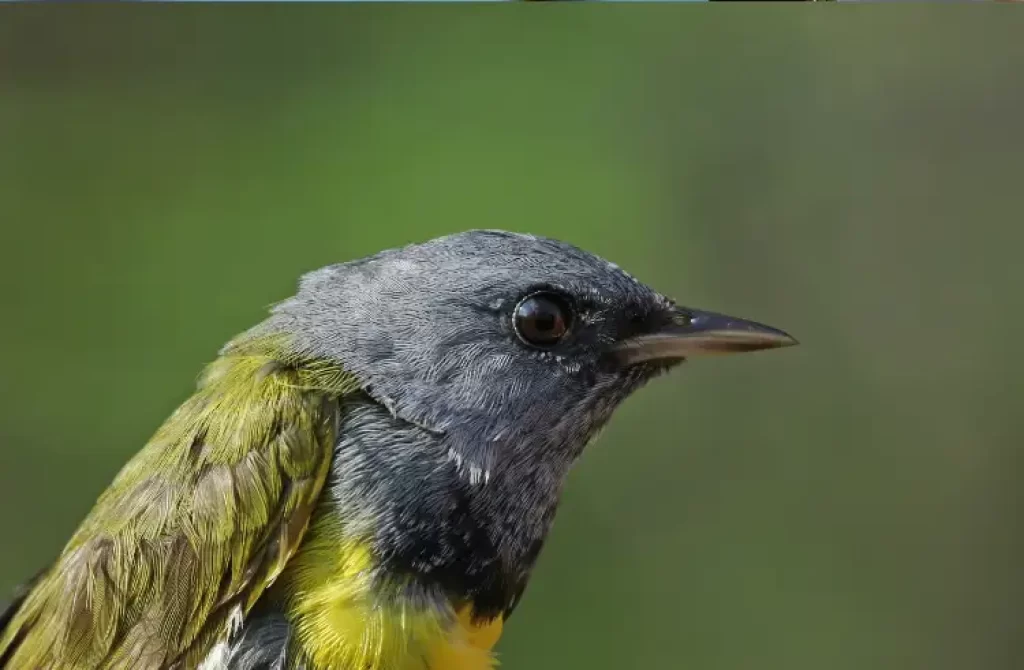
The Mourning Warbler is a small bird that catches the eye with its olive-green back and bright yellow belly. It’s about the size of your palm, making it one of the smaller birds you might see in Florida.
While they don’t call Florida home year-round, they do pass through during their long migration trips. These birds travel a lot, moving between North and Central America depending on the season.
When in Florida, you’re most likely to spot them in the spring or fall. They’re usually found in brushy areas, hopping around looking for insects to snack on.
If you’re out for a walk in Florida’s natural spots during migration season, keep an eye out for this little green and yellow visitor.
15. Black-throated Green Warbler
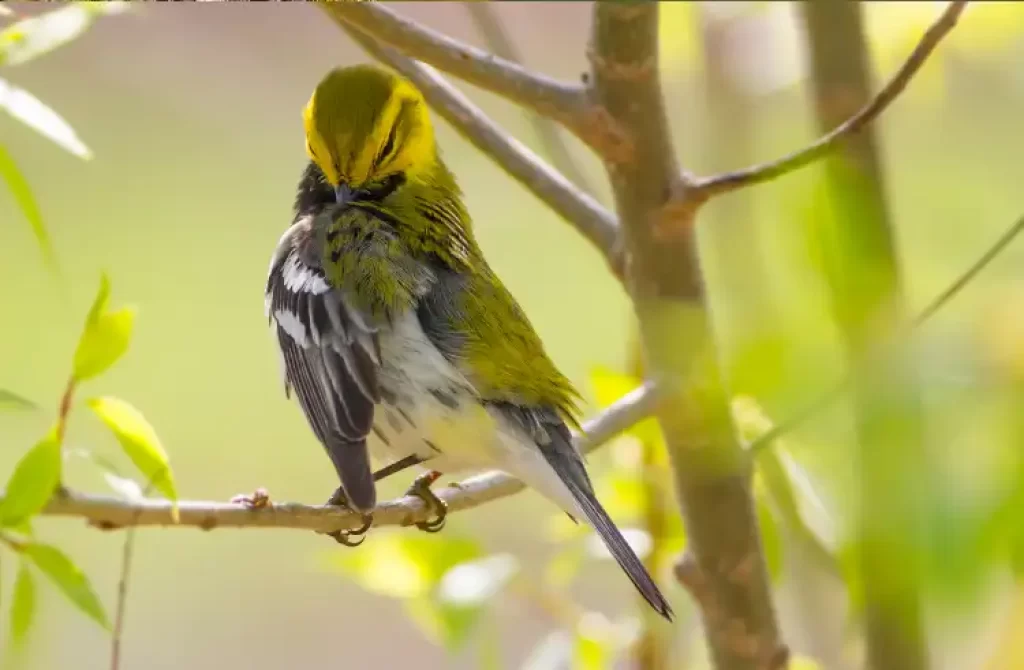
When bird-watching in Florida, the Black-throated Green Warbler is one of the distinctive birds you might encounter. With its olive-green back and a strikingly bright yellow face, it stands out among the tree branches.
Males of this species also sport a unique black throat and chest, making them easy to identify. These warblers are small, usually measuring between 4.5 to 5 inches in length, and weighing about 9 grams.
Their song, a series of musical notes, can often be heard during the breeding season. They prefer dense forests, especially areas with coniferous trees, for nesting.
While they breed in the northern parts of the US and Canada, Florida is a favorite spot for them during migration and winter. So, for those keen on spotting this green bird in Florida, listening for their unique song and looking in wooded areas can increase your chances.
16. Yellow-throated Vireo
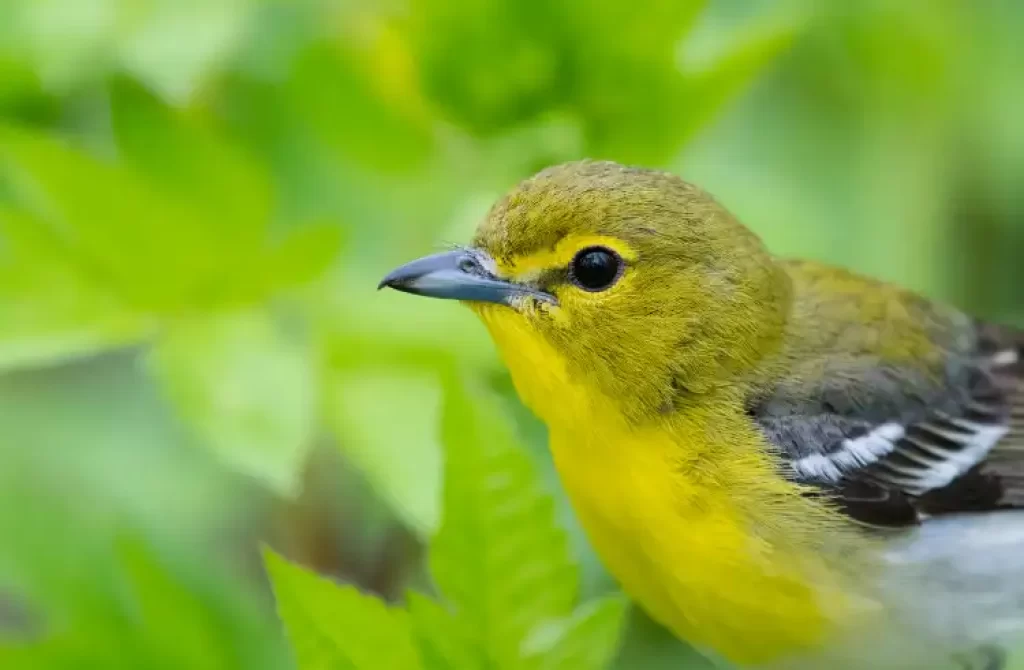
If you’re in Florida and you spot a bird with a radiant yellow throat and chest contrasted by olive-green upper parts, you’re probably looking at a Yellow-throated Vireo. These birds are a medium size, typically about 5 to 5.5 inches long. They have a sturdy build with a distinctive thick bill, which sets them apart from many other songbirds.
Their song, a series of clear and melodic notes, can be a delight to hear on a sunny day. Florida’s thickets, woodlands, and well-vegetated areas are prime spots for these birds, especially during their migration period.
The combination of their unique color pattern and melodious voice makes the Yellow-throated Vireo a sought-after sight for bird enthusiasts and a lovely green bird to spot in Florida.
17. Pine Warbler
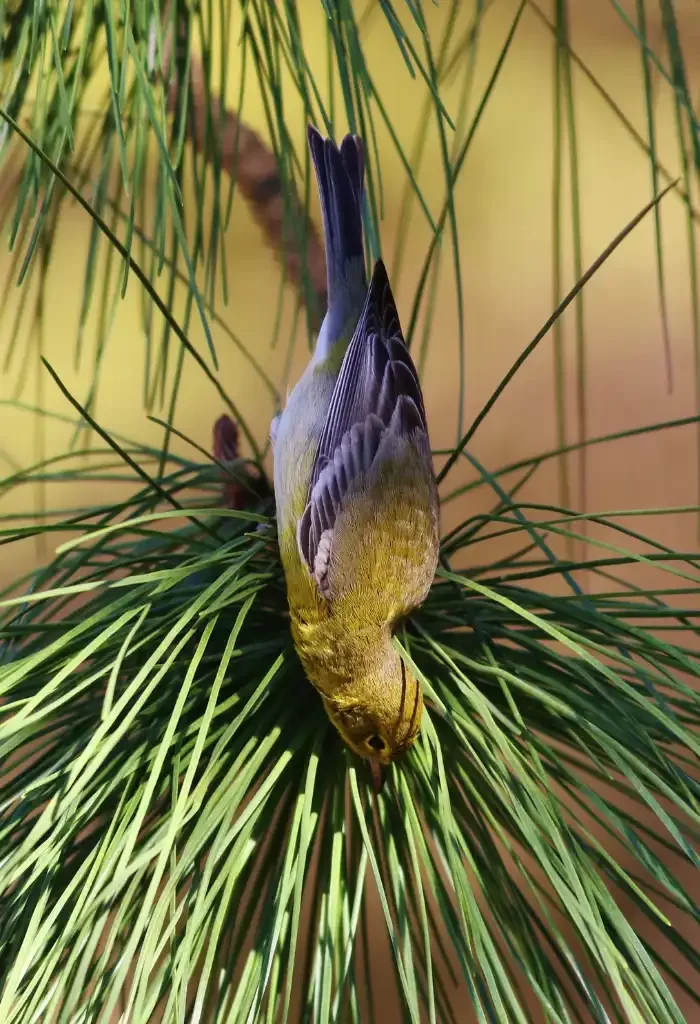
If you’re taking a walk through Florida’s pine woods, you might hear the cheerful song of the Pine Warbler before you see it.
This small bird, about the size of your hand, has a soft olive-green color on its back and wings. It blends right into the pine trees, making it a bit of a fun challenge to spot. But once you hear its song, you’ll know it’s nearby.
The Pine Warbler’s call sounds like a series of short trills and chirps. So, when you’re out in Florida’s woods, listen closely and look out for this little green bird, it’s one of the natural treasures of the state.
18. Orange-crowned Warbler
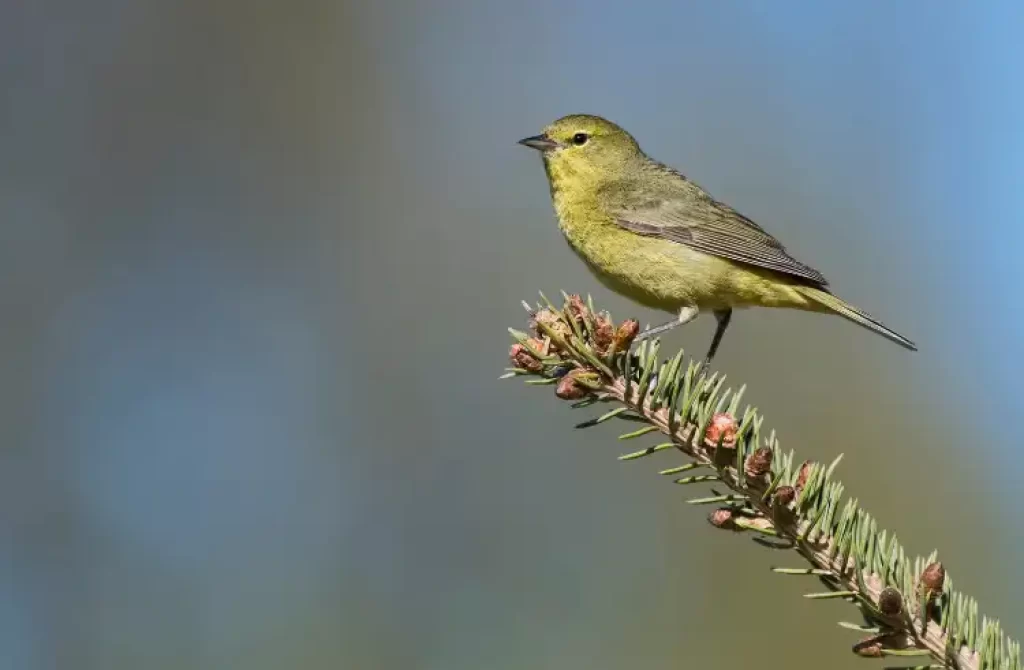
You might think from its name, the Orange-crowned Warbler would be all bright and flashy. But in reality, this bird has a more laid-back style.
Most of its body is olive-green, blending in easily with Florida’s greenery. The “orange crown” part? Well, it’s kinda like a hidden surprise.
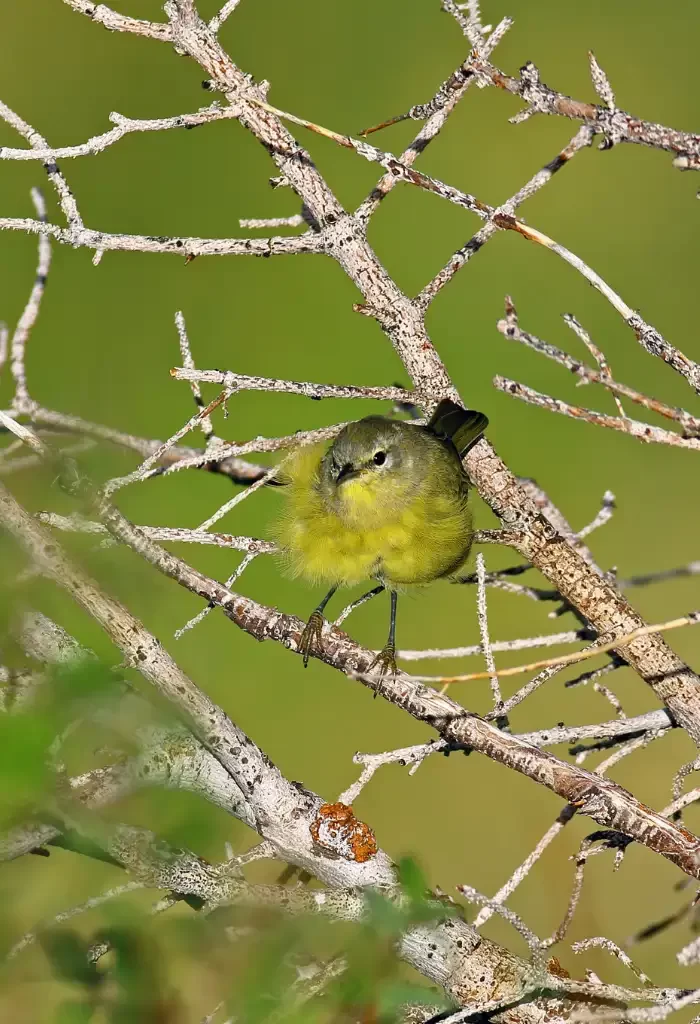
You see, it’s there, but it’s just a tiny patch on their head, and often, it’s so faint or hidden that you might miss it.
These birds are on the smaller side, about the size of your average sparrow. They like to munch on insects and sometimes berries. So if you’re out in Florida’s parks or natural spots, keep a lookout for this cool little green bird with its secret orange crown!
19. Cuban Parrot
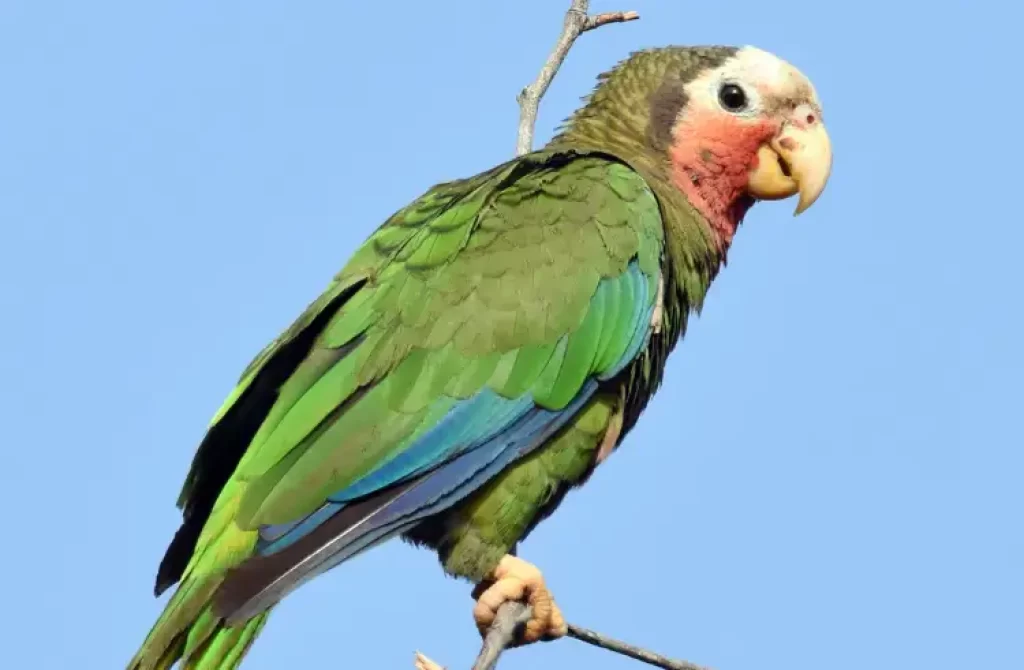
If you’re down in Florida and you happen to come across a vibrant green bird with some eye-catching traits, chances are you’ve stumbled upon a Cuban Parrot.
These parrots are mostly dressed in green, but what really stands out are their distinctive white foreheads and those wing feathers with a cool blue tint. They may not be the biggest parrots around, but they sure do command attention.
Now, here’s the interesting part: Cuban Parrots aren’t originally from Florida, but they’ve managed to settle in and make this place their home. Apart from their striking looks, these parrots are known for their playful personalities and lively chattering. Sometimes, you’ll hear them before you actually see them!
So, if you’re fortunate enough to spot one of these feathered friends, take a moment to appreciate this unique Floridian gem.
Birdwatching spots in Florida where Green Birds are Commonly Seen
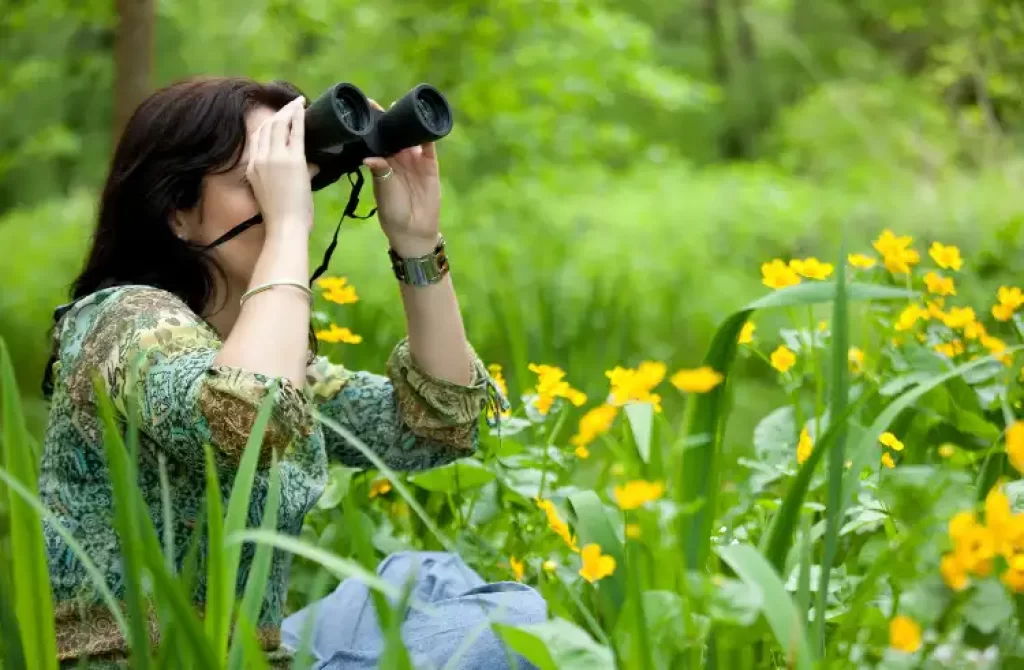
In Florida, there are several birdwatching spots where you can commonly see green birds. Some of these spots include:
Everglades National Park
Everglades National Park, a massive and diverse ecosystem in Florida, provides a habitat for a variety of green birds, like herons, egrets, and even parrots.
If you’re into birdwatching, you’ll want to check out spots like the Anhinga Trail and Shark Valley, which are well-known and beloved destinations for observing these winged creatures in their natural surroundings.
The park’s rich wetlands and lush landscapes make it a haven for both avid birdwatchers and nature enthusiasts alike.
Corkscrew Swamp Sanctuary
Corkscrew Swamp Sanctuary, situated near Naples, offers a fantastic opportunity to spot green herons, bitterns, and various wetland birds in a stunning cypress swamp environment.
This serene sanctuary is a haven for nature enthusiasts and birdwatchers alike, providing a glimpse into the beauty of Florida’s wetlands and the fascinating birdlife that thrives there.
It’s a must-visit destination for anyone looking to connect with nature and observe these enchanting green birds in their natural habitat.
Ding Darling National Wildlife Refuge
Ding Darling National Wildlife Refuge, located on Sanibel Island, is a prime spot to catch sight of green herons, along with a diverse array of wading birds, shorebirds, and waterfowl.
The refuge’s scenic landscapes and well-maintained trails make it an ideal destination for birdwatching enthusiasts.
Whether you’re a seasoned birder or just starting out, this refuge provides fantastic opportunities to connect with nature and observe the captivating green birds and other avian species that call it home.
Merritt Island National Wildlife Refuge
Merritt Island National Wildlife Refuge, situated on Florida’s east coast, is a top-notch destination for birdwatching. Bird enthusiasts can often spot green parrots, warblers, and a variety of waterfowl in the refuge’s diverse habitats.
Whether you’re exploring the coastal areas, wetlands, or wooded sections of the refuge, there are ample opportunities to observe these vibrant green birds and an array of other avian species that thrive in this natural haven for wildlife watchers.
Oleta River State Park
Oleta River State Park, nestled near Miami, is a habitat for Monk Parakeets, one of Florida’s prevalent green bird species.
These birds can be easily spotted in the park’s picnic areas and along its scenic trails. Birdwatchers and nature enthusiasts have the chance to enjoy the company of these charismatic parakeets in a picturesque natural setting, making Oleta River State Park a wonderful place to connect with Florida’s avian wildlife.
Myakka River State Park
Myakka River State Park in Sarasota is famous for its wide variety of birds. When you visit, you’ll often see green herons, anhingas, and other water birds hanging out in the wetlands and along the river.
It’s a great place for birdwatchers to enjoy Florida’s beautiful birds in their natural surroundings.
Loxahatchee National Wildlife Refuge
Loxahatchee National Wildlife Refuge, located in Palm Beach County, is a popular spot for birdwatching. You can spot green herons, egrets, and various water-loving birds in its marshes and canals.
It’s a great place to enjoy the beauty of these birds and Florida’s wetland wildlife in their natural habitat.
FAQs: Green Birds in Florida
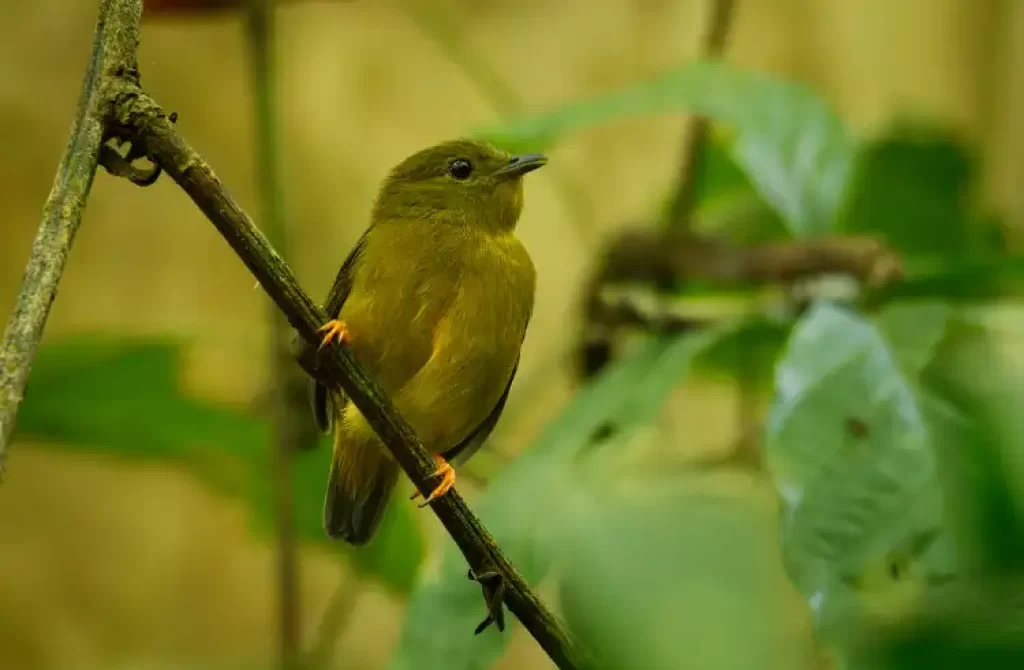
What is the most common green bird species found in Florida?
The most common green bird species in Florida is the Monk Parakeet. The Monk Parakeet, a vibrant green bird, holds the title of the most frequently spotted green avian species in Florida. These parakeets are often seen in urban and suburban areas, thanks to their adaptable nature. They construct large communal nests on utility poles and trees, which serve as their homes.
Are there any endangered green bird species native to Florida?
No, there are no endangered green bird species native to Florida. Florida’s native bird species, while facing various conservation challenges, do not include any green bird species that are currently classified as endangered.
Are there any migratory green bird species that visit Florida during certain seasons?
Yes, several migratory green bird species visit Florida during specific seasons. One notable example is the Painted Bunting, a small, colorful bird with green, blue, and red plumage. They migrate to Florida during the winter months, particularly in the southern parts of the state, to escape colder northern climates.
You Might also like:
Kenno Marques is a self-taught English speaker deeply passionate about nature and wildlife. He dedicates his time to scouring the web for the latest animal news and engaging content, which he shares on various websites. Fluent in three languages, Kenno is currently on a journey to master German. His commitment to fostering an understanding of the natural world makes him a valuable contributor to the online community.






